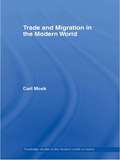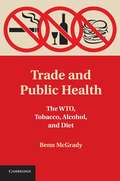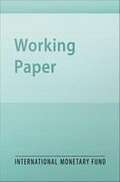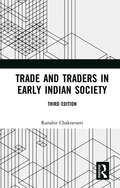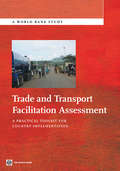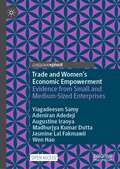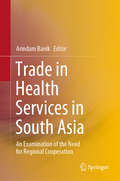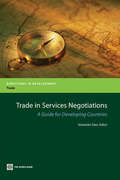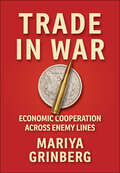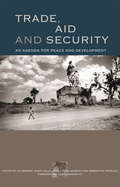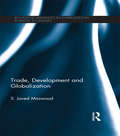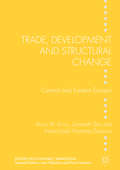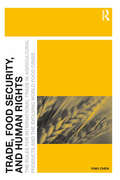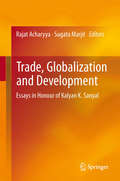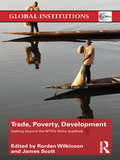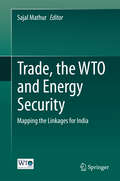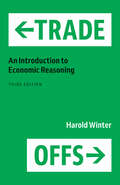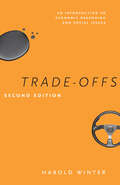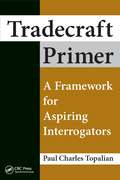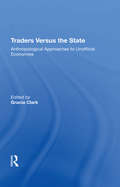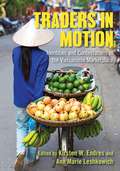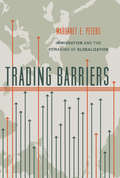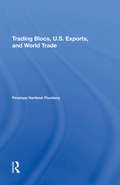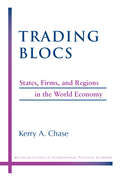- Table View
- List View
Trade and Migration in the Modern World (Routledge Studies in the Modern World Economy #Vol. 55)
by Carl MoskRevolutionized by the growing use of fossil fuels and electricity and the reduced costs of transportation and communications, international trade and migration has received an unprecedented boost in recent years. Using a theory of economic and political gravitation, backed up with both quantitative analysis and qualitative description, Mosk argues that the tendency for trade and migration to flow together is tempered by market forces and political resistance to diversity in migration. This results in a glaring paradox: the political arenas of nation states are divided between embracing and opposing diversity in immigration, the same immigration flows their own policies helped create. A remarkable volume, this book will be invaluable to students of economics demographic historians, policy makers and political scientists.
Trade and Public Health: The WTO, Tobacco, Alcohol, and Diet
by Benn McgradyNon-communicable diseases, associated with risk factors such as tobacco consumption, poor diet and alcohol use, represent a growing health burden around the world. The seriousness of non-communicable diseases is reflected in the adoption of international instruments such as the WHO Framework Convention on Tobacco Control; the WHO Global Strategy on Diet, Physical Activity and Health; and the WHO Global Strategy to Reduce the Harmful Use of Alcohol. In line with these instruments, states are beginning to use measures such as taxes, restrictions on marketing, product regulation and labeling measures for public health purposes. This book examines the extent to which the law of the World Trade Organization restricts domestic implementation of these types of measures. The relationship between international health instruments and the WTO Agreement is examined, as are the WTO covered agreements themselves.
Trade and Thy Neighbor's War
by Mahvash Saeed QureshiA report from the International Monetary Fund.
Trade and Traders in Early Indian Society
by Ranabir ChakravartiHighlighting diverse types of market places and merchants, this book situates the commercial scenario of early India (up to c. ad 1300) in the overall agrarian material milieu of the subcontinent. The book questions the stereotypical narrative of early Indian trade as exchanges in small quantity, exotic, portable luxury items and strongly argues for the significance of trade in relatively inexpensive bulk commodities – including agrarian/floral products – at local and regional levels and also in long distance trade. That staple items had salience in the sea-borne trade of early India figures prominently in this book which points out that commercial exchanges touched the everyday life of a variety of people. A major feature of this work is the conspicuous thrust on and attention to the sea-borne commerce in the subcontinent. The history of Indic seafaring in the Indian Ocean finds a prominent place in this book pointing out the braided histories of overland and maritime networks in the subcontinent. In addition to three specific chapters on the maritime profile of early Bengal, the third edition of Trade and Traders in Early Indian Society offers two new chapters (14 and 15) on the commercial scenario of Gujarat, dealing respectively with an organization of merchants during the early sixth century ad and with the long-term linkages between money-circulation and overseas trade in Gujarat c. ad 500-1500). A new preface to the Third Edition discusses the emerging historiographical issues in the history of trade in early India. Rich in the interrogation of a wide variety of primary sources, the book analyses the changing perspectives on early Indian trade by taking into account the current literature on the subject.
Trade and Transport Facilitation Assessment: A Practical Toolkit for Country Implementation
by John Arnold Jean Francois Arvis Brendan Horton Monica Alina Mustra Robin Carruthers Lauri OjalaThe 'Trade and Transport Facilitation Assessment' (TTFA) is a tool for identifying inefficiencies in international supply chains that limit a country's ability to compete in international trade. The TTFA examines problems that affect not only exports competitiveness, but also the ability to import and distribute inputs to production and consumer goods. This new TTFA toolkit was developed to meet the growing demand for facilitation and logistics reforms in an environment of increasing global competition and expanded trade in intermediate goods. It reflects practical experience and the change in the nature of demand from developing countries. The TTFA focuses on simplification and harmonization of trade-related procedures and identifies the opportunities for improving logistics services, infrastructure, and the overall performance of specific supply chains. It also outlines practices to develop plans of action with proper interactions with government agencies and stakeholders.
Trade and Women’s Economic Empowerment: Evidence from Small and Medium-Sized Enterprises
by Yiagadeesen Samy Adeniran Adedeji Augustine Iraoya Madhurjya Kumar Dutta Jasmine Lal Fakmawii Wen HaoThis open access book examines the relationship between trade and women’s economic empowerment by focusing on small and medium enterprises (SMEs) in six countries: Cambodia, Ghana, Madagascar, Nigeria, Senegal and Vietnam. The authors make use of both survey data and qualitative analysis to understand why and how trade can create more jobs for women, and how the jobs created are contributing to women’s empowerment. They propose strategies and policies for ensuring that women can benefit from trade. After providing the context for the research and reviewing the literature on trade and gender in the introductory chapter, the second chapter analyzes survey data collected for this project. This is followed by a qualitative analysis of the six country cases in the next two chapters: Cambodia and Vietnam (Chapter 3), followed by Ghana, Madagascar, Nigeria and Senegal (Chapter 4). The final chapter concludes with a summary of our findings and policy recommendations.
Trade in Health Services in South Asia: An Examination of the Need for Regional Cooperation
by Arindam BanikThis book observes that an in-depth study exclusively focusing on health service trade not only strengthens the overall services trade capacity of the South Asian region, but also promotes global as well as regional trade. There is a dearth of analytical research on estimating barriers to trade in health services, particularly in the context of South Asia, and as such, this book assesses the potential benefits and economic costs of barriers to trade in health services in select South Asian economies. It also analyzes the impact of liberalization and regulatory reforms on economic welfare. It broadly addresses issues relating to trade in health services, the GATS (General Agreement on Trade in Services), such as: Why are the current levels of trade in health services low? How will the GATS legally affect a country’s health policy? What effect might liberalization have on national health systems? And what are the likely benefits of greater trade in health services? It also provides specific answers to the following questions: Does the substantial role of the government in health – as health service provider, financial supporter, regulator and promoter – have implications for the treatment of the sector under the GATS? What is the impact of liberalization of international trade in health services on the quality and availability of health services in developing SAARC countries? Given the importance of consumption abroad for trade in health services, and the gradual opening of health markets through Modes 1 and 3 (cross-border supply and commercial presence), how can problems associated with trade in these Modes be prevented? And are these problems sufficiently addressed by GATS disciplines? Answers to these questions will be of great use to researchers, policy makers as well as practitioners and NGOs of South Asia.
Trade in Services Negotiations: A Guide for Developing Countries
by Sebastián SáezThis book aims at contributing to address some of the challenge that developing countries, especially the least-developing countries, face in the design of trade in service policies and to provide governments with tools to better incorporate services in their export strategies, including negotiations and cooperation with trading partners, and unilateral reforms. This book helps to identify key policy challenges faced by developing country trade negotiators, regulatory policy officials and/or service suppliers. Management of both policy reforms and trade agreements requires investments in sounder regulatory regimes and the establishment of enforcement mechanisms to help countries gradually opening and mitigate any potential downside risks. A successful strategy requires a proper sequencing that through an orderly and transparent process allows to prepare for greater competition. Developing countries face serious resource and administrative constraints to adequately negotiate multiple services agreements that serve their trade interest. For many developing countries, the administrative burden of handling and negotiating multiple trade agreements has become a serious concern and this can hamper their opportunities to obtain adequate market access for their services exports. The book develops in detail the methodological framework for the construction of a database and the core elements that will comprise it, to help countries to organize and manage their services commitments. Little attention has been devoted to the organization/preparation and the development, assessment and conclusion of the negotiation process. The book presents a simulation exercise designed for policymakers, trade negotiators, and trade practitioners working in the area of services. This exercise will help them to better understand the preparatory and negotiating stages of the process leading to liberalization of trade in services.
Trade in War: Economic Cooperation across Enemy Lines (Cornell Studies in Security Affairs)
by Mariya GrinbergTrade in War is an urgent, insightful study of a puzzling wartime phenomenon: states doing business with their enemies. Trade between belligerents during wartime should not occur. After all, exchanged goods might help enemies secure the upper hand on the battlefield. Yet as history shows, states rarely choose either war or trade. In fact, they frequently engage in both at the same time. To explain why states trade with their enemies, Mariya Grinberg examines the wartime commercial policies of major powers during the Crimean War, the two World Wars, and several post-1989 wars. She shows that in the face of two competing imperatives—preventing an enemy from increasing its military capabilities, and maintaining its own long-term security through economic exchange—states at war tailor wartime commercial policies around a product's characteristics and war expectations. If a product's conversion time into military capabilities exceeds the war's expected length, then trade in the product can occur, since the product will not have time to affect battlefield outcomes. If a state cannot afford to jeopardize the revenue provided by the traded product, trade in it can also occur. Grinberg's findings reveal that economic cooperation can thrive even in the most hostile of times—and that interstate conflict might not be as easily deterred by high levels of economic interdependence as is commonly believed. Trade in War compels us to recognize that economic ties between states may be insufficient to stave off war.
Trade, Aid and Security: An Agenda for Peace and Development
by Oli Brown'A compelling contribution to our evolving understanding of the links between trade, aid and security ? and what the international community needs to do to ensure peace and development in the world.' Achim Steiner, Executive Director, United Nations Environment Programme 'For far too long the international community ahs stood by while countries around the world descend into conflict and anarchy. We need to understand how we can engage more effectively with fragile and failing states. Trade, Aid and Security is an important step in this direction.' Jan Pronk, Special Representative of the UN General Secretary in Sudan and Former Minister of Development and the Environment, The Netherlands. 'As we begin to contemplate what the post-Iraq world will look like it is vital that we reflect on the limits of the utility of hard power and the importance that development can play in avoiding failed states before they fail, preventing conflicts and more successfully re-building states. This timely book makes a most important contribution to that process.' Lord Paddy Ashdown, UN High Representative for Boznia and Herzegovina, 2002 ? 2006 Leader of UK Liberal Democrat Party, 1988 ? 1999 'As UN Special Representative to the Great Lakes Region of Africa I have seen the devastating impact of the trade in ?conflict resources? with my own eyes. Amongst much else, this book shows how different trade and aid politics can tackle the trade in conflict resources and make a real contribution to secure societies. It is essential reading.' Mohamed Sahnoun, Special Representative of the UN Secretary General in Central and East Africa. Iraq, Afghanistan, Darfur. All resonate loudly on the international stage, exposing and illustrating the intractable links between global security, control over naturals resources ? be it oil, water, timber or 'conflict diamonds' ? and the manipulation of foreign aid and international trade policy. This volume, written by leading authorities from across the globe, introduces the linkages between trade, aid and security, and exposes how inappropriate or misused trade and aid policy can and do undermine security and contribute to violence and the disintegration of national states. On a practical level they demonstrate how six key areas of trade and aid policy can be used to help forge stability and security, reduce the likelihood of armed conflict, and assist economic and political recovery in our war-torn world.
Trade, Development and Globalization (Routledge Advances in International Political Economy)
by Syed Javed MaswoodThis book provides a longitudinal study of developing country involvement in multilateral trade negotiations. The trade regime established at the end of the Second World War did not cater for, and in some cases excluded, the developmental interests of the newly independent countries. This book offers a detailed analysis of: The first attempts to revise the trade regime in the 1960s through the United Nations Conference on Trade and Development and the formation of the Group of 77 to enhance their bargaining potential. The mixed coalition strategy, with the Cairns Group in the Uruguay Round of GATT. The new bargaining coalition, the Group of Twenty, that took on a much more confrontational and assertive bargaining position in the unsuccessful Doha round of the World Trade Organization. In part two, the author explores the possibility that economic globalization may finally deliver to developing countries what they had failed to achieve in five decades of multilateral negotiations - an opportunity to climb the industrialization ladder and achieve development. The book offers a proposal for revising the format of trade negotiations in a way that helps overcome stalemates and deadlocks. Trade, Development and Globalization will be of interest to students and scholars of international trade, trade and development, negotiation, global governance, political economy, international relations and economics.
Trade, Development and Structural Change: Central and Eastern Europe (Studies in Economic Transition)
by Anca M. Voicu Somnath Sen Inmaculada Martinez-ZarzosoThis book examines the evolution of trade and trade patterns in Central and Eastern European countries (CEEC) and assesses the implications of these patterns on structural change and economic development within transition economies. Taking the fall of the Iron Curtain in 1989 as a starting point, the authors discuss the transition of former communist CEE countries from centrally planned to market-driven economies, arguing that trade was the primary engine for the economic growth and transition process they experienced. The chapters in this book incorporate the results of previous studies – some of which are based on original research conducted by the authors – dedicated to the integration process of international and European trade. More importantly, the authors look at the broader aspects of structural change and economic development, indeed the whole process of economic transformation. Thus, the book moves well beyond the core ‘trade and growth’ framework to look at technological progress, foreign investment, institutional development and structural change in Central and Eastern European countries.
Trade, Food Security, and Human Rights: The Rules for International Trade in Agricultural Products and the Evolving World Food Crisis
by Ying ChenMost scholars attribute systemic causes of food insecurity to poverty, human overpopulation, lack of farmland, and expansion of biofuel programs. However, as Chen argues here, another significant factor has been overlooked. The current food insecurity is not absolute food shortage, since global food production still exceeds the need of the entire world population, but a problem of how to secure access to resources. Distorted agricultural trade undermines world food distribution, and uneven distribution impedes people’s access to food, particularly in poor developing countries. Examining EU and US agricultural policies and World Trade Organization negotiations in agriculture, the author argues how they affect the international agricultural trade, claiming that current food insecurity is the result of inequitable food distribution and trade practices. The international trade regime is advised to reconcile trade rules with the consideration of food security issues. Several other enforceable solutions to reduce world hunger and malnutrition are also advanced, including national capacity building, the improvement of governance, and strategic development of biofuel programs. This book will be of great interest to agricultural trade professionals and consultant policy makers in the EU, US and developing countries. Students and researchers with a concentration on international trade, agriculture economics, global governance and international law will benefit greatly from this study.
Trade, Globalization and Development: Essays in Honour of Kalyan K. Sanyal
by Sugata Marjit Rajat AcharyyaThis book was written in honour of Professor Kalyan K. Sanyal, who was an excellent educator and renowned scholar in the field of international economics. One of his research papers co-authored with Ronald Jones, entitled "The Theory of Trade in Middle Products" and published in American Economic Review in 1982, was a seminal work in the field of international trade theory. This paper would go on to inspire many subsequent significant works by researchers across the globe on trade in intermediate goods. The larger impact of any paper, beyond the number of citations, lies in terms of the passion it sparks among younger researchers to pursue new questions. Measured by this yardstick, Sanyal's contribution in trade theory will undoubtedly be regarded as historic. After completing his Ph.D. at the University of Rochester he joined the Department of Economics at Calcutta University in the early 1980s and taught trade theory there for almost three decades. His insights, articulation and brilliance in teaching international economics have influenced and shaped the intellectual development of many of his students. After his sudden passing in February 2012, his students and colleagues organized a symposium in his honour at the Department of Economics, Jadavpur University from April 19 to 20, 2012. This book, a small tribute to his intellect and contribution, has been a follow-up on that endeavour, and a collective effort of many people including his teachers, friends, colleagues and students. In a nutshell it discusses intermediation of various kinds with significant implications for market integration through trade and finance. That trade can generate many non-trade-service sector links has recently emerged as a topic of growing concern and can trace its lineage back to the idea of the middle product, a recurring concept in Prof. Sanyal's work.
Trade, Poverty, Development: Getting Beyond the WTO's Doha Deadlock (Global Institutions)
by James Scott Rorden WilkinsonThis work seeks to look beyond the seemingly endless deadlock in the WTO’s Doha round of trade negotiations that began in November 2001 and were first scheduled to conclude by January 1, 2005. As well as offering an incisive analysis of the ills of the round, with particular attention directed at the poorest and least developed countries, the book expands on how the round could be moved forward elaborating on the Statement on the Doha Development Agenda that was negotiated in Johannesburg . The work as a whole provides the reader with a critical analysis of the implications of the negotiations for development and poverty reduction as well as proposals for moving beyond the current impasse. The volume brings together contributions from serving and former ambassadors to the WTO, key practitioners, and civil society representatives along with those of leading scholars. Each chapter explores an area of critical importance to the round; and together they stand as an important contribution to debates not only about the Doha round but also about the role of trade in the amelioration of poverty in the poorest countries.
Trade, the WTO and Energy Security
by Sajal MathurThe linkages between WTO rules governing trade and energy security with a certain degree of focus on India are the main subject of this book. The edited volume brings together the views of academics, policymakers and experts with extensive experience covering WTO and international trade issues. The issues examined include mapping the linkages between trade and energy security in the WTO agreements, case law, accession and Doha negotiations; assessing the issues that could be raised by energy deficit or energy surplus countries at the WTO; analyzing the provisions of the ECT and NAFTA vis-à-vis the Indian policy framework and examining the trade regimes of selected OPEC members and other major suppliers of fossil fuels to India. While the Indian perspective is evident in the contributions, this book will also be of interest to an international audience, as trade, the WTO and energy security are global concerns and of relevance to all practitioners and academics working on these issues.
Trade-Offs: An Introduction to Economic Reasoning
by Harold WinterThe highly engaging introduction to thinking like an economist, updated for a new generation of readers. When economists wrestle with any social issue—be it unemployment, inflation, healthcare, or crime and punishment—they do so impersonally. The big question for them is: what are the costs and benefits, or trade-offs, of the solutions to such matters? These trade-offs constitute the core of how economists see the world—and make the policies that govern it. Trade-Offs is an introduction to the economic approach of analyzing controversial policy issues. A useful introduction to the various factors that inform public opinion and policymaking, Trade-Offs is composed of case studies on topics drawn from across contemporary law and society. Intellectually stimulating yet accessible and entertaining, Trade-Offs will be appreciated by students of economics, public policy, health administration, political science, and law, as well as by anyone following current social policy debates.
Trade-Offs: An Introduction to Economic Reasoning
by Harold WinterThe highly engaging introduction to thinking like an economist, updated for a new generation of readers.When economists wrestle with any social issue—be it unemployment, inflation, healthcare, or crime and punishment—they do so impersonally. The big question for them is: what are the costs and benefits, or trade-offs, of the solutions to such matters? These trade-offs constitute the core of how economists see the world—and make the policies that govern it.Trade-Offs is an introduction to the economic approach of analyzing controversial policy issues. A useful introduction to the various factors that inform public opinion and policymaking, Trade-Offs is composed of case studies on topics drawn from across contemporary law and society.Intellectually stimulating yet accessible and entertaining, Trade-Offs will be appreciated by students of economics, public policy, health administration, political science, and law, as well as by anyone following current social policy debates.
Trade-Offs: An Introduction to Economic Reasoning and Social Issues
by Harold WinterWhen economists wrestle with issues such as unemployment, inflation, or budget deficits, they do so by incorporating an impersonal, detached mode of reasoning. But economists also analyze issues that, to others, typically do not fall within the realm of economic reasoning, such as organ transplants, cigarette addiction, overeating, and product safety. "Trade-Offs "is an introduction to the economic approach to analyzing these controversial public policy issues. Harold Winter provides readers with the analytical tools needed to identify and understand the trade-offs associated with these topics. By considering both the costs and benefits of potential policy solutions, Winter stresses that real-world decision making is best served by an explicit recognition of as many trade-offs as possible. This new edition incorporates recent developments in policy debates, including the rise of "new paternalism," or policies designed to protect people from themselves; alternative ways to increase the supply of organs available for transplant; and economic approaches to controlling infectious disease. Intellectually stimulating yet accessible and entertaining, "Trade-Offs" will be appreciated by students of economics, public policy, health administration, political science, and law, as well as by anyone who follows current social policy debates.
Tradecraft Primer: A Framework for Aspiring Interrogators
by Paul Charles TopalianTradecraft Primer: A Framework for Aspiring Interrogators is a timely and relevant reference manual for a new generation of professionals as we enter a new era in our nation‘s interrogation programs. A must-read for anyone thinking of entering the interrogation profession, whether in law enforcement, the military, or intelligence, it provides fresh
Traders Versus The State: Anthropological Approaches To Unofficial Economies
by Gracia ClarkThis book addresses the multifaceted issue of the state vis-a-vis those perceived as actors in the informal or simple commodity production economy. It discusses both state and traders' strategies to display recurrent themes, emphasized and combined differently in specific contexts.
Traders in Motion: Identities and Contestations in the Vietnamese Marketplace
by Kirsten W. Endres Ann Marie LeshkowichWith essays covering diverse topics, from seafood trade across the Vietnam-China border, to street traders in Hanoi, to gold shops in Ho Chi Minh City, Traders in Motion spans the fields of economic and political anthropology, geography, and sociology to illuminate how Vietnam's rapidly expanding market economy is formed and transformed by everyday interactions among traders, suppliers, customers, family members, neighbors, and officials.The contributions shed light on the micropolitics of local-level economic agency in the paradoxical context of Vietnam's socialist orientation and its contemporary neoliberal economic and social transformation. The essays examine how Vietnamese traders and officials engage in on-the-ground contestations to define space, promote or limit mobility, and establish borders, both physical and conceptual. The contributors show how trading experiences shape individuals' notions of self and personhood, not just as economic actors, but also in terms of gender, region, and ethnicity. Traders in Motion affords rich comparative insight into how markets form and transform and what those changes mean.Contributors:Lisa Barthelmes, Christine Bonnin, Gracia Clark, Annuska Derks, Kirsten W. Endres, Chris Gregory, Caroline Grillot, Erik Harms, Esther Horat, Gertrud Hüwelmeier, Ann Marie Leshkowich, Hy Van Luong, Minh T. N. Nguyen, Nguyen Thi Thanh Binh, Linda J. Seligmann, Allison Truitt, Sarah Turner
Trading Barriers: Immigration and the Remaking of Globalization
by Margaret E. PetersWhy have countries increasingly restricted immigration even when they have opened their markets to foreign competition through trade or allowed their firms to move jobs overseas? In Trading Barriers, Margaret Peters argues that the increased ability of firms to produce anywhere in the world combined with growing international competition due to lowered trade barriers has led to greater limits on immigration. Peters explains that businesses relying on low-skill labor have been the major proponents of greater openness to immigrants. Immigration helps lower costs, making these businesses more competitive at home and abroad. However, increased international competition, due to lower trade barriers and greater economic development in the developing world, has led many businesses in wealthy countries to close or move overseas. Productivity increases have allowed those firms that have chosen to remain behind to do more with fewer workers. Together, these changes in the international economy have sapped the crucial business support necessary for more open immigration policies at home, empowered anti-immigrant groups, and spurred greater controls on migration.Debunking the commonly held belief that domestic social concerns are the deciding factor in determining immigration policy, Trading Barriers demonstrates the important and influential role played by international trade and capital movements.
Trading Blocs, U.s. Exports, And World Trade
by Penelope Hartland-thunbergThis book points out that although the total trade volume of the blocs that involve less-developed countries (LDCs) has increased, this is due at least as much to a particular bloc-member's economic growth as it is a result of the trading bloc.
Trading Blocs: States, Firms, and Regions in the World Economy
by Kerry A. ChaseExamining the domestic factors that underlie the creation of trading blocs, Chase (political science, Tufts U.) finds that businesses in industries with large returns to scale have been key forces in the emergence of trading blocs, especially in those cases in which they carry political clout. His study of the creation and impact of trading blocs examines the interwar cases of Japan, Britain, and Germany; the US from 1922 to 1967; the European Union; the North American Free Trade Agreement; and Japan in the 1980s and 90s. Beyond establishing the thesis of the significance of economies of scale on bloc formation, the book is concerned with the questions of the impact of trading blocks on the multilateral integration of the world economy and on economic, political, and military conflict and cooperation between regions. Annotation ©2006 Book News, Inc., Portland, OR (booknews.com)
